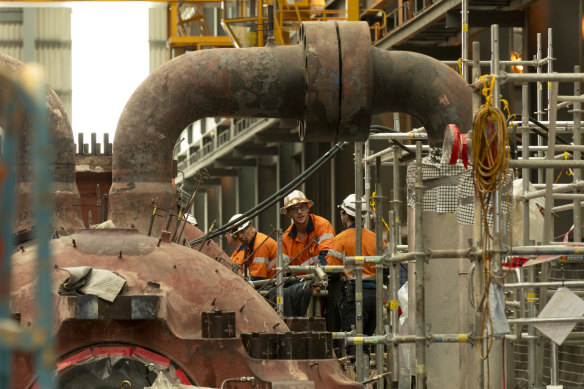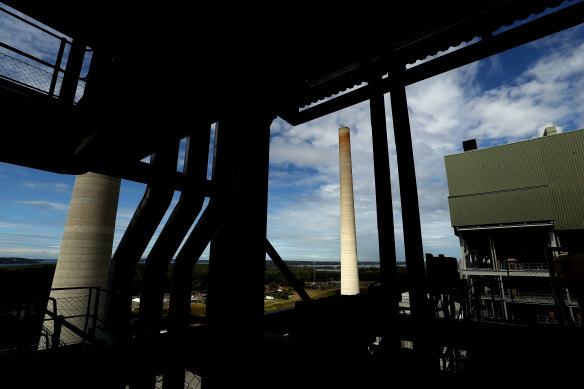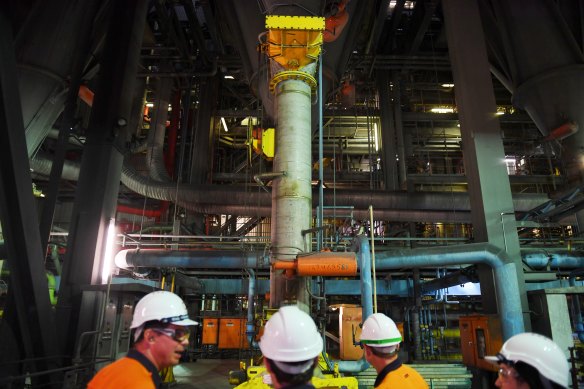This was published 10 months ago
Why is Australia still burning so much coal? Inside the power plant that just can’t close
Australia’s energy transition has a timing problem: we have enough renewables to undermine coal, but not enough yet to replace it. That means plants like Origin Energy’s Eraring are being forced to stay in the mix.
By Mike Foley and Nick Toscano

The Eraring power station.
Between soaring smoke stacks and piles of deep black coal, a team in the control room at Australia’s biggest coal-fired power station checks the pulse of the electricity market every five minutes and makes an important decision: either turn down or ramp up the generators that power millions of homes and businesses.
If the grid needs a boost, a signal is sent for more coal to be dropped into a quartet of gigantic steel caverns, called boiler rooms, which are filled with flames to produce the steam that flows into turbines and spins their blades.
Origin Energy’s Eraring power station, on the shores of Lake Macquarie, has been producing electricity since the 1980s, and still supplies 22-28 per cent of all the power in NSW.
As Australia finally takes major strides in cleaning up its power sector, though, the grid looks a lot different to what it did 40 years ago. Emissions have come down sharply with the shift to green energy, but the intermittency of wind and solar also means supply and demand are no longer evenly matched. This causes wild swings in the prices that generators are paid for producing electrons – and when prices crater, no one feels it more than the coal-fired power stations that can’t easily be switched off.

Eraring Power Station’s cavernous turbine hall crushes and burns as much as 6 million tonnes of coal.Credit: Bloomberg
Eraring takes the biggest hit right in the middle of the day, explains Jonathon Lawless, the plant’s control room shift manager. When the east-coast grid is overflowing with cheap power from solar farms and millions of Australians’ rooftop panels, the electricity supplied by Eraring’s coal-fired turbines simply can’t compete. The plant has been working to lower the minimum output of each of its four generating units by 15 per cent in a bid to stem the severity of its losses.
“It’s cheaper to run at a loss for a period of time than it is to turn them off and start back up,” Lawless says.
In 2022, Origin pointed out such “rapidly evolving” market conditions when announcing it would bring forward Eraring’s closure by several years – to as early as August 2025.
“The reality is the economics of coal-fired power stations are being put under increasing, unsustainable pressure by cleaner and lower-cost generation,” Origin chief executive Frank Calabria said at the time.
The intensifying pressure on ageing coal plants like Eraring due to cheaper and cleaner renewables is, at first glance, resoundingly good news for the climate: electricity production ranks as Australia’s biggest source of greenhouse gas emissions, and we pollute more per capita from burning coal than any other developed country.
But Australia’s energy transition has a timing problem: we have now installed enough renewables to undermine the viability of coal, experts warn, but not enough to actually replace it. And we can’t turn off the old system until the new system is ready.
“Nothing is being built on time,” says Matt Rennie, co-chief executive of energy consultancy Rennie Advisory.
“The energy industry is struggling with both cost and time pressure in the rush to retain the prospect of fairly priced reliable power at the end of this decade when coal starts to close.”
Following the closure of 10 coal-fired power stations since 2012, the rubber is about to hit the road: at least half of the remaining 14 plants on the eastern seaboard are now slated to shut within a decade, as electric utilities AGL, Origin and EnergyAustralia move to fast-track retirement dates of facilities that are becoming less reliable and less competitive. The Australian Energy Market Operator (AEMO) thinks that number could be even higher, with its latest modelling suggesting 90 per cent of the grid’s coal capacity is likely to have exited by 2035.
That risks leaving a huge gap when the wind isn’t blowing and the sun isn’t shining, which governments worry is not being filled.
Not enough large wind and solar farms are being built in time to compensate for more coal closures without heightening the risk of power prices spikes or blackouts, officials say. Nor are there enough new power lines to connect far-flung wind and solar areas to major cities, or enough grid-scale batteries and hydroelectric dams to store renewable energy for when the sun goes down and the wind disappears.

Eraring Power station in the NSW Central Coast is the largest of its type in Australia and provides a substantial percentage of Australia’s grid.Credit: Nick Moir
Instead of closing Eraring by this time next year, Origin will now keep it running until at least 2027. The NSW government cut a deal with the company in May to push back the plant’s retirement because delays in the rollout of new energy infrastructure had left the state too vulnerable.
A similar situation has unfolded in Victoria – arguably the most pro-renewable of any state – where the government has already intervened with financial support to ensure two of its biggest coal-fired generators – EnergyAustralia’s Yallourn and AGL’s Loy Yang A – do not shut down prematurely.
“Australia’s great energy transition – from fossil fuels to renewables – is not going well,” says Grattan Institute energy director Tony Wood, who predicts further deals to delay other impending coal closures are likely to follow.
“Governments have lost faith in the market being able to deliver enough electricity to the right places at the right time, consumers are fuming about high power prices, and investors have been spooked by frequent and unpredictable government interventions.”
Despite running behind schedule, Australia’s massive shift from coal to renewables ranks among the fastest of any country in the world. While coal still supplies more than 50 per cent of our electricity, billions of dollars are pouring into green energy projects each year, and renewables now account for more than 40 per cent of the mix. As a result, greenhouse gas emissions from the grid have come down sharply, falling nearly 29 per cent from their peak in 2009.
To limit global warming well below 2 degrees – the level the Paris Agreement deems necessary to avert the worst effects of climate change – scientists say the world must reach a balance between the emissions it produces and those it removes from the atmosphere, known as “net zero” emissions.
The Albanese government is aiming to double the share of renewable energy to at least 82 per cent by 2030 as part of its commitment to cutting national emissions by 43 per cent on 2005 levels and reaching net zero by 2050.
But many across the energy industry think Australia’s chance of reaching these targets is slipping quickly, in large part due to the slower-than-required deployment of renewables.
“Australia’s window to stay on a well-below-2-degree pathway is closing fast,” says Leonard Quong, head of Australian research at Bloomberg New Energy Finance.
“Rapidly moving to a clean power system based on wind, solar and storage will be essential to cost-effectively reduce carbon emissions in line with our existing decarbonisation targets – but the heavy lifting must be done this decade.”
‘It can’t be just flick the switch and it’s off and the grid is stable and everyone’s got their energy. There has to be a transition.’
Jonathon Lawless
The limitations of Australia’s existing renewable energy, storage and transmission capacity – and the grid’s ongoing reliance on fossil fuels – were brought into sharp focus this year when Australia sweltered through its third-hottest summer on record.
Early in the year, hot and humid conditions in Queensland and NSW dramatically increased demand for electricity from energy-hungry air-conditioners, which forced coal and gas plants to ramp up output and plug supply gaps once the sun went down and solar power receded.
Then in winter, a prolonged stretch of cold weather collided with a rare wind lull across the eastern seaboard, limiting generation from wind turbines, while lower-than-average rainfall reduced output from hydroelectric dams. This forced more-expensive fossil fuels into greater use to meet spiking demand yet again.
Due to the “increasing contribution of coal-and gas-fired generation to the total generation mix”, emissions from the power sector rose 1.7 per cent in the March quarter, according to the federal Energy Department, then a further 1.3 per cent in the three months to June.
This meant Australia’s overall emissions virtually flatlined across the full financial year, falling just 0.9 per cent.
Climate Change and Energy Minister Chris Bowen says the data shows the government’s renewable energy plan is working, “but after a decade of denial and delay, we must continue to drive action across all sectors of the economy”.

A steam turbine from Eraring’s Unit 3 dismantled for the maintenance overhaul.
On the edge of Lake Macquarie, Eraring had its busiest year since 2019 as it ramped up coal-fired output by 2.1 terawatt-hours to 14.3 terawatt-hours (equal to 7 per cent of all the electricity used in the grid).
Just minutes down the road, however, Origin has also been progressing work on an energy project more suited to the 2020s – a powerful battery system designed to soak up excess wind and solar energy in the day and dispatch it when the sun sets and demand spikes, or when the grid needs a critical injection to maintain stability.
Jay Foggin, Origin’s head of energy storage, says the system will include about 2 million individual cells in the prime location next to the coal plant, with a high-capacity connection to the existing transmission network.
Back in the plant’s control room, Lawless, who has watched the electricity market evolve over the past 20 years, shares the same view as many energy experts on Australia’s shift to clean energy, and how the Eraring situation neatly encapsulates the complexities.
“We realise that we have to do it, and it makes 100 per cent sense to transfer to renewables – but it can’t be just flick the switch, and it’s off, and the grid is stable and everyone’s got their energy,” he says.
“There has to be a transition.”
The Business Briefing newsletter delivers major stories, exclusive coverage and expert opinion. Sign up to get it every weekday morning.